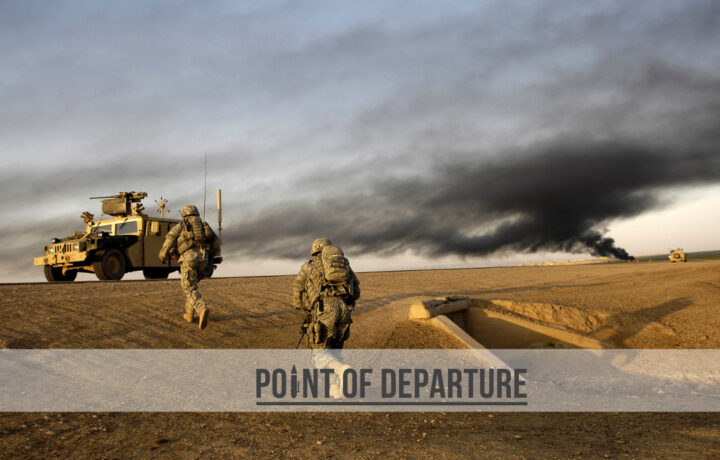Every good war story begins with “There I was…”
Twenty years ago, there I was, leaning against my HMMWV wondering how anyone could deploy to war without current maps. Our lone functioning Blue Force Tracker was no longer functioning. The maps issued to the S-3 in Kuwait were safely locked away in a container. And we were lost somewhere in Iraq’s southwestern desert. Lost might be too strong a word. We were on a road; we just weren’t sure it was the right road.
Although I’d pre-programmed our route of march into a small handheld Garmin GPS, no one was quite ready to put their trust into a device they didn’t understand. So, I reached into my MOLLE assault pack and pulled out the tattered Gulf War era aviation maps that I’d used for planning for the past year and spread them across the hood of the vehicle. We gathered around the vehicle, confirmed our location, and were back on the road in relatively short order.
Looking back, it was a hell of a way to start to a war.
THE LESSONS OF iraq WAR
The year that followed offered no shortage of similar such incidents, euphemistically called “teaching moments” or “learning opportunities,” depending on your perspective and who was doing the teaching and who might be doing the learning. In retrospect, we were doing a lot more learning and a lot less teaching than we might have hoped.
Many of those lessons weren’t new. Fighting a desert war on familiar terrain reinforced lessons from the Gulf War. Movement control, a hallmark of Desert Storm that demanded strict discipline for operational and tactical movement on supply routes, was almost non-existent, leading to frequent confusion and at least one unfortunate incident. Adherence to the principles of just in time logistics—perhaps in the attempt to avoid the mountains of supplies accumulated during Desert Shield—allowed support organizations to be more agile but decidedly less responsive to the needs of maneuver forces.
However, the lesson most often emphasized was that of leadership. In organizations that fostered what we know today as the principles of mission command, decisive leaders achieved remarkable results. Then-Colonel David Perkins led 3rd Infantry Division’s 2nd Brigade on the Thunder Run on Baghdad, sparking the collapse of Saddam Hussein’s government. Further north, the city of Fallujah was forever etched in Marine Corps history as then-Major General James Mattis led his 1st Marine Division in the first major insurgent battle, Operation Vigilant Resolve. And in Mosul, the-Major General David Petraeus defined the template for stability operations while leading the 101st Airborne Division.
STRATEGERY
But, as we so often learn, tactical victories don’t always equate to strategic success. Iraq was no different. As much as those tactical wins added up over time, we were losing the war strategically. In fact, you could argue that we started losing the war before it started. From the moment Colin Powell spoke before the United Nations on October 18, 2001—a moment he regretted to the end of his life—we took our first steps in the wrong direction. The decision to present that argument, and four others that ultimately followed, sealed our fate strategically.
1. Intelligence matters.
The case to go to war begins and ends with one word: Curveball. Rafid Ahmed Alwan al-Janabi was an Iraqi defector who fed Western intelligence services the fabricated information that established the case for war. None of the intelligence services bothered to confirm Curveball’s elaborate lies about weapons of mass destruction, probably a good indication that the road to war had already been paved.
2. Never high five on the objective.
One of the great myths of the war is that there was no plan for governance in the wake of regime collapse, no grand scheme for post-conflict stability operations. In truth, there was a plan. And a capable team led by our most experienced senior leader in Iraq, Jay Garner. The failure to implement that plan remains one of the worst decisions of the war.
3. The golden hour only rings once.
In trauma care, the golden hour refers to the need for an injured patient to receive definitive care within the first 60 minutes. The same principle applies in the aftermath of conflict, when the need arises to establish security and some form of stability for the civilian populace. Because of one bad decision—see above—we missed the golden hour and spent the next several years trying to limit the collateral damage.
4. Avoid kicking the hornet’s nest.
When L. Paul Bremer—DOD’s choice to replace Garner—arrived as the first proconsul in Iraq, he immediately set to work fomenting chaos. Within a day of arriving, he issued CPA Order No. 1, relegating any member of the Ba’ath Party—the only people with any knowledge of how to run the country—to only the lowest government posts. But that decision paled in comparison to CPA Order No. 2—issued the following day—which disbanded the Iraqi army and set in motion the forces that would unleash years of bloody insurgency.
5. Go big or go home.
When the day finally arrived to end combat operations in Iraq at the end of 2011, we put our best foot forward and built a comprehensive strategy around a 10,000-troop stay behind force to continue the training mission, which was promptly rejected by Prime Minister Nouri al-Maliki. The administration ultimately chose to try to meet the objectives of that strategy with just 157 people, an impossible task that arguably helped to spawn ISIS.
Truth be told, I rarely tell war stories of my time(s) in Iraq, or restrict those I do tell to M*A*S*H-style tales of combat silliness. They don’t sting as much in the retelling, and almost always end with a hearty chuckle. After 20 years, we could all use a good laugh.




